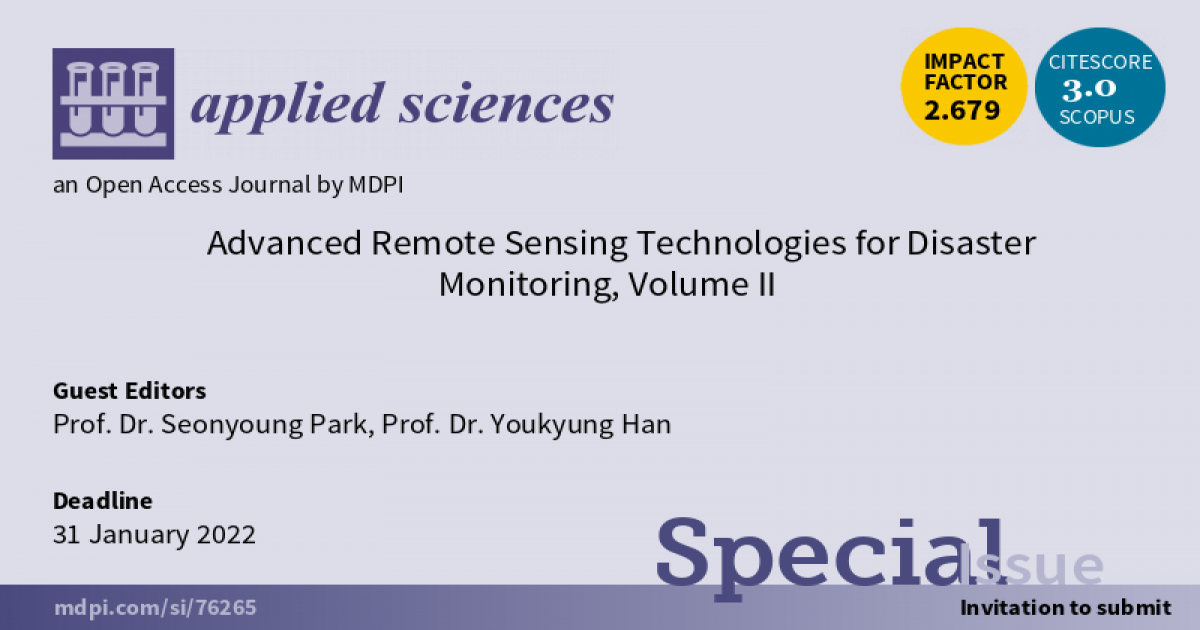Advanced Remote Sensing Technologies for Disaster Monitoring, Volume II
A special issue of Applied Sciences (ISSN 2076-3417). This special issue belongs to the section "Environmental Sciences".
Deadline for manuscript submissions: closed (20 September 2022) | Viewed by 6248

Special Issue Editors
Interests: drought; evapotranspiration; disaster; environmental impact assessment; soil and water conservation; remote sensing and GIS; agriculture
Special Issues, Collections and Topics in MDPI journals
Special Issue Information
Dear Colleagues,
For the last decade or so, there has been intense research activity regarding the exploitation of remote sensing technologies in disasters such as drought, extreme temperatures, earthquakes, cyclones, flooding, landslides, wildfires, etc. Climate change is affecting the occurrence of disasters, resulting in the higher vulnerability of regions to severe events. It is important to prevent, mitigate, and recover from disasters by monitoring these disasters using enhanced technologies. Remote sensing is one of such technologies that is suitable for effectively collecting data on a large scale with varied spatial, spectral, and temporal resolutions. A mass of satellite data has been employed to monitor disasters, identify the damage due to disasters, and assess the recovery from disaster.
This Special Issue invites state-of-the-art research on disaster monitoring using satellite remote sensing data. In this Special Issue, we expect to introduce various studies covering remote sensing technologies that can be applied in disaster monitoring.
Prof. Dr. Seonyoung Park
Prof. Dr. Youkyung Han
Guest Editors
Manuscript Submission Information
Manuscripts should be submitted online at www.mdpi.com by registering and logging in to this website. Once you are registered, click here to go to the submission form. Manuscripts can be submitted until the deadline. All submissions that pass pre-check are peer-reviewed. Accepted papers will be published continuously in the journal (as soon as accepted) and will be listed together on the special issue website. Research articles, review articles as well as short communications are invited. For planned papers, a title and short abstract (about 100 words) can be sent to the Editorial Office for announcement on this website.
Submitted manuscripts should not have been published previously, nor be under consideration for publication elsewhere (except conference proceedings papers). All manuscripts are thoroughly refereed through a single-blind peer-review process. A guide for authors and other relevant information for submission of manuscripts is available on the Instructions for Authors page. Applied Sciences is an international peer-reviewed open access semimonthly journal published by MDPI.
Please visit the Instructions for Authors page before submitting a manuscript. The Article Processing Charge (APC) for publication in this open access journal is 2400 CHF (Swiss Francs). Submitted papers should be well formatted and use good English. Authors may use MDPI's English editing service prior to publication or during author revisions.
Keywords
- monitoring natural hazards
- landslides and land degradation
- climate change
- land use and land cover change
- typhoon
- droughts
- floods, and floodplains
- earthquakes
- tsunamis
- hazard and vulnerability assessments
- risk mapping
- early warning systems
Benefits of Publishing in a Special Issue
- Ease of navigation: Grouping papers by topic helps scholars navigate broad scope journals more efficiently.
- Greater discoverability: Special Issues support the reach and impact of scientific research. Articles in Special Issues are more discoverable and cited more frequently.
- Expansion of research network: Special Issues facilitate connections among authors, fostering scientific collaborations.
- External promotion: Articles in Special Issues are often promoted through the journal's social media, increasing their visibility.
- e-Book format: Special Issues with more than 10 articles can be published as dedicated e-books, ensuring wide and rapid dissemination.
Further information on MDPI's Special Issue polices can be found here.






